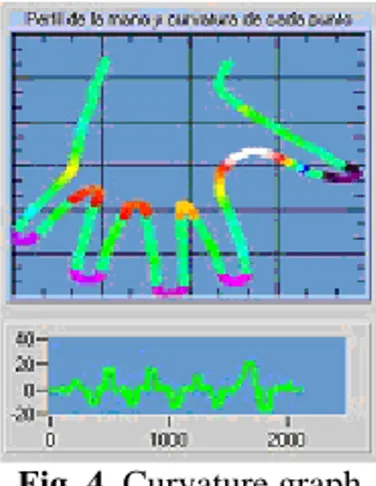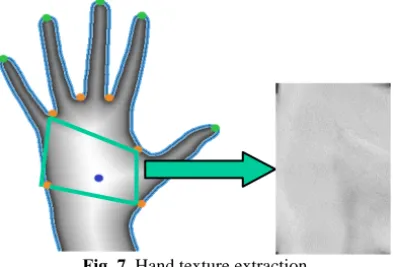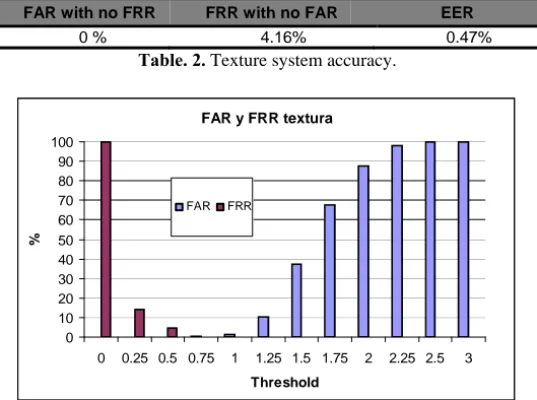Classification Accuracy improvements by the use of
simultaneous biometric measurements: Hand palm
recognition.
Artzai Picón,1, Alberto Isasi1, Aritz Villodas1 1TECNALIA-Infotech
ROBOTIKER-Tecnalia, Parque Tecnológico, Edificio 202. E-48170 Zamudio (Bizkaia) (SPAIN)
Tel. +34 94 600 22 66, Fax. +34 94 600 22 99
{apicon, aisasi, avillodas}@robotiker.es
Abstract. Biometric systems can achieve good results on their own. Sometimes, the single use of one biometric feature does not suit properly the application requirements because of the fact that the security level has to be extremely high. To achieve this requirement, it is possible to use a multimodal biometric system. This implies that the user must pass through a set of biometric devices to login in each one. This process could be sometimes overwhelming for the users and, for this reason, a new multimodal hand-palm-print identification device is proposed. Within this approach, the acquisition of the different biometric measures is done at the same time.
Keywords: Biometrics, Hand recognition, Machine vision, Pattern recognition, Security, Multimodal Biometrics.
1 Introduction
Biometrics is the technology which can identify and obtain human features using physical characteristics or behavior. These technologies can make a relationship between a person and his pattern in a safe and non-transferable way.
The verification of the person’s identity based on the measurements of the palmprint is presented as a safe and very economic method allowing its implementation in lots of Biometric applications.
There are two working modes in a biometric system: Authentication and identification. Authentication consists of verifying whether the person is who he pretends to be (1vs1). Identification consists of obtaining the identity of a person searching in a database so the customer has not to tell the system who he is (1vsN).
To measure the performance of a biometric system False Acceptance Rate and False Rejection Rate terms are used [1][2]. FAR (False Acceptance Rate): it is defined as the point per cent of the users who are accepted by the system when should not have been accepted. FRR (False Rejection Rate): it is defined as the point per cent of the users who are rejected by the system when should have been accepted. EER (Equal Error Rate): it is defined as the threshold in which FAR and FRR are equal so a true user have the same possibilities of being rejected as a fake user of being accepted.
Biometric measurement is a high reliable technique. However, this confidence can change depending on what is being measured. This reliability can range from the security given by face or fingerprint recognition, to the high-confidence given by iris or retina based systems.
Therefore, in some cases, the use of a single biometric feature is not capable to reach the desired security level. To face this, the combination of different measures from different sources (biometrical or not) can really strengthen the security. For example, the user can combine a fingerprint system with a PIN number to get two different inputs or maybe, a high security authentication device can be designed merging an iris recognition system with a password given by voice. The more inputs the system has, the higher the system security will be against authentication errors.
By this reason, it would be worthy to be able to design a multimodal device, diminishing both the discomfort and the user’s rejection caused by this kind of systems.
The proposed way to reduce this discomfort is based on engineering a methodology that could perform multibiometric recognition using a single capture of the biometric features.
This approach has been tested in a proposed prototype which is able to extract different biometric features of the user from his hand. This system obtains the “palm print” through a single capture from an off-the-self scanner. Proposed algorithms extract on one hand, the geometry of the hand, and, on the other hand information about the texture of the image.
In this way, the system copes with biometric processing performing a dual recognition but having only to perform a single capture step. This approach achieves dual systems’ robustness but keeping the one-device traditional simplicity.
2 Developed
Prototype
The prototype developed consists of a software system which takes charge of the processing and the management of the data obtained from each user using a database, and of a hardware module constituted by a PC Scanner and a compatible PC.
This prototype allows camera or scanner image acquisition, user registration, information centralization in a database accessible from several ID checkpoints.
Fig.1 Developed prototype picture.
3. Feature extraction
To obtain these characteristics this method is applied
- Hand image acquisition. - Hand isolation.
- Detection of points of interest. - Geometrical characteristics extraction. - Texture characteristics location.
a. Geometric features extraction
A colour image is directly obtained from the scanner.
Fig. 1. Acquired Image
The method consists of obtaining the hand edges to allow the detection of finger intersections and finger ends through the hand shape curvature.
Fig. 2. Hand Obtained Borders
Fig.3. Curvature estimation
IB
IA
IB
IA
⋅
∧
=
=
Sin
(
α
)
Curvature
(1)After calculating the curvature values in the array it is observed that the finger ends are corresponded to the valleys in the curvature graph and the fingers intersection are corresponded to the peaks of the graph (Fig. 4).
Fig. 4. Curvature graph
Fig. 5. Main points extracted from the captured image
Using these points, and some characteristics related to the distance of a point inside the hand to the closest border point, we are able to create the feature vector of a hand image.
Fig. 6. Hand extracted characteristics image
Finally 48 characteristics are extracted from a hand and used to create a hand feature vector.
{
}
TM
X
X
X
1,
2,...,
=
X
(2)b. Texture characteristic extraction
As well as the previous characteristics, a texture feature extraction is needed to perform a texture based classification.
reduce the amount of information contained in the texture, a PCA (Principal component analysis) based reduction method is chosen.
Fig. 7. Hand texture extraction
Based on this method, each texture image is described as a vector, and the mean of these textures is used to generate the mean based PCA vectors as described in [8] for face recognition. This way of generating the PCAs diminishes spectacularly the intraclass differences as low noisy information is not captured by the PCA based on mean vectors.
4. Classifiers
The two types of features extracted are classified by the use of statistical gaussian classifiers. In the case of geometrical features, this is done directly. However, the high dimensionality of the data makes necessary the use of dimension reduction schemes to avoid the Hughes phenomenon. A simple combination of classifiers is proposed for dual classification.
a. Hand geometry classification
Let X (2) be an m components feature vector of the geometric distances obtained from one person’s hand. And let n be the number of hand images of that person. Assuming a Gaussian distribution of the geometric features, a Gaussian model can be created for each of the classes creating what is known as user’s template.
The mean vector and the covariance matrix are calculated using each class samples to estimate the gaussian properties of that class.
)
(
1
∑
=
=
Nn n
ML
x
(
)
T ML n N n ML n MLN
x
μ
x
μ
Σ
=
∑
−
−
=)
(
1
1 (4)Using that information, a gaussian model of each class is created as shown in (5).
⎭ ⎬ ⎫ ⎩ ⎨ ⎧− − ∑− − ∑ = ∑
Ν 2( ) ( )
1 2 / 1 2 / 1 ) · 2 ( 1 ) , ( μ x μ x 1 μ x T e D
π
(5)After modeling each class, any incoming vector will be checked for classification against all the modeled classes and its belonging probability will be calculated for each of them measuring its distance to each of the classes (6).
)
(
)
(
12
=
x
−
μ
Σ
x
−
μ
Δ
T −(6)
The value indicates the similarity of the present vector with one template of a
person. is smaller if the feature vector has been obtained from a hand of the same person the template belongs. This allows the use of that value as a measurement of distance or probability.
2
Δ
2
Δ
b. Hand texture classification
Due to its high dimensionality, palm print texture information’s dimensionality is reduced using the widely known Karhunen-Loève transform also known as PCA [5, 6, 7]. PCA is defined as the orthogonal projection of the data onto a lower dimensional subspace where the variance of the projected data is maximized.
After transformation, the feature vector is represented by the X vector in the reduced dimensionality space defined by the PCA eigenvectors. This representation avoids the curse of dimensionality as well as decorrelates and compresses the information contained in the spectrum allowing the creation of simpler classifiers and smaller training sets.
After transformation, feature vectors are classified in the same way as defined for geometric features.
c. Combined classification
This increases in an additive way the probability of FRR, but diminishes the probability of FAR in a multiplicative way.
Texture Geometry ACCEPTED
ACCEPTED
ACCEPTED
P
P
P
=
·
(7)Texture Geometry REJECTED
REJECTED REJECTEDD P P
P = · (8)
5.
Experimental Results
Authentication tests were accomplished using 155 hand images from 14 different persons, using 5 images from each person to create the 14 templates and the rest of them were used to test the system.
To determine the classifier performance, each test image was crossed against the 14
templates observing the distances produced (3) whether they belong to the same person or not.
a. Hand geometric recognition
The obtained performance of the biometric system is shown in Table.1 and in Fig.8.
FAR with no FRR FRR with no FAR EER
0.6 % 14% 2.25%
Table. 1. Geometric system accuracy.
FAR y FRR
0 10 20 30 40 50 60 70 80 90 100
0 50 100 150 200 250 300 350 400 450 5001000 2000 3000400 0 500 0 600 0 700 0 8000900
0 100
00 11000120
00 130 00 140 00 150 00 threshold FAR FRR
b. Hand texture recognition
The previous classifiers do not use the hand texture information to make their decision. The use of Mahalanobis classifier is proposed to accomplish this.
Fig. 9 Hand textures from two different persons
35 hand textures were used against the previous calculated classifiers (as described in [5] for face recognition systems) obtaining a very low error rates.
Mahalanobis distance was used as threshold to accept or reject a person and the results are shown in Table.6 and in figure.11.
FAR with no FRR FRR with no FAR EER
0 % 4.16% 0.47%
Table. 2. Texture system accuracy.
FAR y FRR textura
0 10 20 30 40 50 60 70 80 90 100
0 0.25 0.5 0.75 1 1.25 1.5 1.75 2 2.25 2.5 3
Threshold
%
FAR FRR
c. Dual classification
This classification can be tuned by changing the threshold of the two previous classifiers. The idea is to tune each of the individual classifier to its EER so the combined one will be working in the optimal individual parameterization. Taking this into account, the following results were obtained:
Feature EER
GEOMETRY 2.25%
TEXTURE 0.47 %
Table.3. Individual systems’ accuracy
The results obtained by the combined system were so good, being quite close to the theoretical expected results.
FAR FRR
0,01% 2.81% Table 4. Dual system’s accuracy
6. Result Discussion
The results obtained in geometric features based classification are very promising, similar or better than the ones obtained by other groups as is presented in Bulatov et al [4].
- Jain et.al. FAR of 2% and a false rejection rate (FRR) of 15%. - Jain and Duta FAR of 2% and FRR 3:5%.
- Raul Sanchez-Reillo et. al. error rates below 10% in verification - Bulatov et al. FAR 1% y FRR 3 %.
Our results using the geometric features obtain a FAR of 0.6% and a FRR of 14% and changing the threshold sensibility we obtain a result of FAR 2% and FRR 3% as shown in Fig.8.
Hand texture based classification has obtained really amazing results, better than ones obtained using geometrical features.
The results using texture features obtain a FAR of 0% and a FRR of 4.16%, and changing the sensibility of the threshold we get a FAR of 0.47% and a FRR of 0% (as shown in Fig.11) being these results better than other groups obtained ones.
The combination of the two biometric measures using the simple method of voting (7, 8) obtains even better results and a more robust system against intrusions because of the fact that the source data comes from 2 different biometric characteristics.
What is more, using the combined method, the system achieves a very good performance (0.01% FAR with a 2.81% FRR). It implies a great security level and it is done using just one biometric device performing two different measures at the same time.
7. Future Work
To validate the result it is planned to repeat the tests using a huge number of images and persons.
The texture and geometric features will be combined to get a better performance in identification and authentication tasks.
Due to the good results obtained with texture features, it is planned to extend the present texture area to other hand areas such as fingers.
In the future it would be possible to add, in the same measure acquired now, a new biometric information source: fingerprints.
Taking advantage of the image obtained through the palmprint scanner, user’s fingerprints can be also processed to introduce the biometric recognition of the 5 fingerprints of the user into the system.
Normally, it will be not necessary to include all the fingerprints into the user profile; it might be possible to select the ones that will be used to build the user profile.
This selection would be done depending on the desired security necessities. Using the five user fingerprints there will be seven different biometric information sources increasing system security a great deal.
Although fingerprint can be easily observed at good quality in the acquired images, it has to be determined whether this quality is enough to allow fingerprints’ minutiae location.
7. Conclusions
According to the results, it can be appreciated that the palm print texture recognition is a bit more reliable than geometric one. However, merging both of them, a much more reliable authentication system is built.
One of the main advantages of this approach is that a dual authentication is performed using a single capture. In this way, the user does not have to use different authentication devices for biometric features extraction (iris, voice, fingerprint...)
As a conclusion, proper design can allow to obtain the same benefits as multimodal biometric devices using a simple device and without overwhelming the users by taking multiple measures in several devices for authentication.
8. References:
1. J. A. Gutierrez et al, “Estado del Arte: El Reconocimiento Biométrico.” Robotiker, 2002.
2. V. Espinosa Duró, “Evaluación de sistemas de reconocimiento biométrico”, Departamento de Electrónica y Automática. Escuela Universitaria Politécnica de Mataró. 2001.
3. R. Sanchez-Reillo, et al, “Biometric identification through hand geometry measurements”, IEEE Transactions on Pattern Analysis and Machine Intelligence, 22(10):1168–1171, 2000.
4. Y. Bulatovet et al, “Hand recognition using geometric classifiers”, DIMACS Workshop on Computational Geometry, Rutgers University, Piscataway, 2002.
5. Pedro Mª Iriondo, “Reconocimiento automático de caras basado en el análisis de características físicas y la expresión”, Tesis Doctoral, Escuela superior de ingeniería de Bilbao, 2000.
6. C. M. Bishop, “Pattern recognition and machine learning”, Springer, 2006, ISBN-10: 0-387-31073-8.





